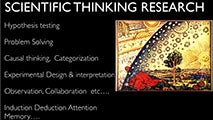Research
We Use Three Main Ways of Investigating Analogical/Metaphorical/Relational Thinking

Naturalistic contexts. When we observe scientists using analogy and metaphor in their labs or families using analogies in museums, or even politicians using these forms of relational reasoning, we have found that these different groups are much more likely to see and use the underlying concepts (themes, mechanisms, or relations) than participants are in traditional cognitive experiments or in the school classroom. One hypothesis that we have proposed for these findings is that in the naturalistic contexts people are generating the analogies themselves rather than being given the analogy by the researcher or teacher. This Isabelle Blanchette and I have found that students are much more likely to see and use the underlying analogical relations when they generate the analogies themselves. Research that we are conducting in our lab at the moment is providing new insights into how and why this happens.
Educational Neuroscience research on Analogy. We have been conducting neuroimaging research on analogical thinking using fMRI (with former students Adam Green and Jonathan Fugelsang) and discovering the key roles that specific networks of brain sites (including the dorsolateral prefrontal cortex, frontopolar context, and the Superior Temporal Gyrus) play in analogical and relational reasoning. Using functional Near Infrared Spectroscopy (fNIRS), we have been able to plot the time course of activation of these sites (with Evelyn Forster at the University of Toronto). These different neuroimaging paradigms are now allowing us to propose more detailed models of how analogy works in the brain and suggest educational interventions that can be used to facilitate a more effective use of analogy and metaphor in the classroom and the lab.
We Use Three Main Ways of Investigating Scientific Thinking

Investigations of Scientists as they Think, Reason, and Interact in their own labs (Invivo Scientific Reasoning). When seeking to understand complex thought processes such as the progression of thought leading to a scientific discovery, traditional avenues can be inadequate. Thus, to uncover what it is that scientists really do it is important to investigate scientists "live" as they think and reason in their laboratories. " Dr. Dunbar has spent extended periods of time (four months to a year) in molecular biology and immunology laboratories, videotaping and audiotaping scientists at work in their laboratories in the United States, Canada, and Italy. Analyses of the types of reasoning that scientists use at these meetings, supplemented by pre and post meeting interviews with individual lab members, has made it possible to uncover the thinking and reasoning mechanisms used by scientific minds. We also investigate familes as they think, reason interact and discuss science when they attend science museums. Often we then go back into our own lab and investigate what we have discovered in the naturalistic situations.
Educational Neuroscience research on Scientific Thinking and Reasoning. We have used fMRI, fNIRS, and EEG to investigate the neural underpinnings of Scientific Thought, that in conjunction with our behavioral research are shedding light on why some scientific concepts are difficult to acquire, test, and evaluate. This leads us to designing educational interventions that have the potential to transform Science Education.
We Use Three Main Ways of Investigating Creativity

Investigating Creativity in our Lab. One of the often mentioned mechanisms of creativity is divergent thinking, another is analogy. We have used a variety of different creative thinking tasks, such as the Alternate Uses of Objects task, groups of students (rather than individuals), to explore the sets of processes underlying creativity. Thus, rather than creativity being a thing that people have a certain amount of, we find that changes in the contexts in which we investigate creativity, the backgrounds of the creators, and the way that the participants frame their goals can have la large influence on the extent and originality of Creative products.
Neuroscience research on creativity. We have been using a combination of imaging and computational methods to investigate creativity. We have used fMRI to investigate divergent thinking using the alternate uses task (in collaboration with Adam Green). We have also used a computational method called Latent Semantic Analysis in which we can objectively measure how novel a new idea actually is (work done in collaboration with Evelyn Forster, Adam Green, and also with Denis Dumas). Using this method we have been able to discover which interventions increase students likelihoods of generating a creative concept, and of discovering the role of the brain in generating creative concepts. This research is ongoing.